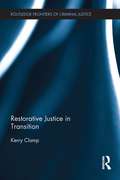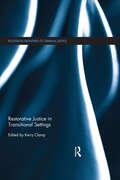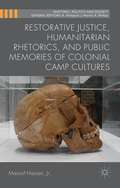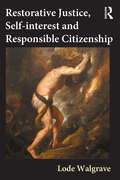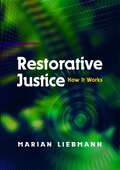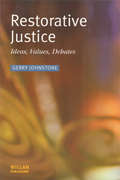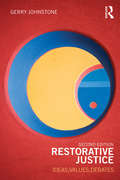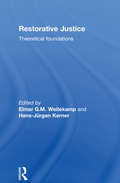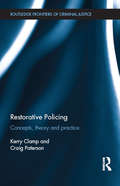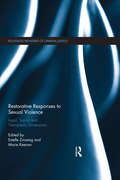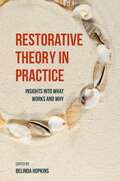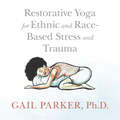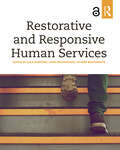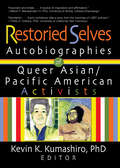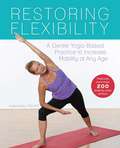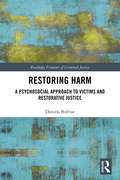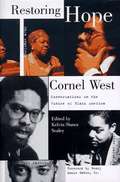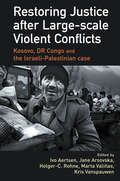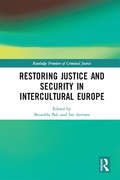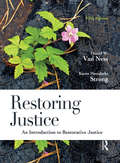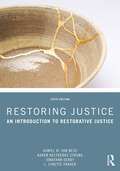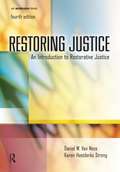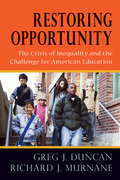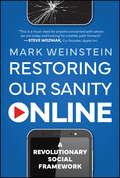- Table View
- List View
Restorative Justice in Transition (Routledge Frontiers of Criminal Justice)
by Kerry ClampThis book explores how restorative justice is used and what its potential benefits are in situations where the state has been either explicitly or implicitly involved in human rights abuses. Restorative justice is increasingly becoming a popular mechanism to respond to crime in democratic settings and while there is a burgeoning literature on these contexts, there is less information that focuses explicitly on its use in nations that have experienced protracted periods of conflict and oppression. This book interrogates both macro and micro utilisations of restorative justice, including truth commissions, criminal justice reform and the development of initiatives by communities and other non-state actors. The central premise is that the primary potential of restorative justice in responding to international crime should be viewed in terms of the lessons that it provides for problem-solving, rather than its traditional role as a mechanism or process to respond to conflict. Four values are put forward that should frame any restorative approach – engagement, empowerment, reintegration and transformation. It is thought that these values provide enough space for local actors to devise their own culturally relevant processes to achieve longstanding peace. This book will be of interest to those conducting research in the fields of restorative justice, transitional justice as well as criminology in general.
Restorative Justice in Transitional Settings (Routledge Frontiers of Criminal Justice)
by Kerry ClampRestorative justice is increasingly being applied to settings characterized by large-scale violence and human rights abuses. While many embrace this development as an important step in attempts to transform protracted conflict, there are a number of conceptual challenges in transporting restorative justice from a democratic setting to one which has been affected by mass victimisation or civil war. These include responding to the seriousness and scale of harms that have been caused, the blurred boundaries between victims and offenders, and the difficulties associated with holding someone to account and compelling reparative activities. Despite reams of paper being devoted to defining restorative justice within democratic settings (where the concept first emerged), restorative scholars have been slow to comment on the integration of restorative justice into the transitional justice discourse. Restorative Justice in Transitional Settings brings together a number of leading scholars from around the world to respond to this gap by developing and further articulating restorative justice for transitional settings. These scholars push the boundaries of restorative justice to seek more effective approaches to addressing the causes and consequences of conflict and oppression in these diverse contexts. Each chapter highlights a limitation with current conceptions of restorative justice in the transitional justice literature and then suggests a way in which the limitation might be overcome. This book has strong interdisciplinary value and will be of interest to criminologists, legal scholars, and those engaged with international relations and peace treaties.
Restorative Justice, Humanitarian Rhetorics, and Public Memories of Colonial Camp Cultures
by Jr. Marouf HasianThe concentrations camps that existed in the colonised world at the turn of the 20th Century are a vivid reminder of the atrocities committed by imperial powers on indigenous populations. This study explores British, American and Spanish camp cultures, analysing debates over their legitimacy and current discussions on retributive justice.
Restorative Justice, Self-interest and Responsible Citizenship
by Lode WalgraveLode Walgrave has made a highly significant contribution to the worldwide development of the restorative justice movement over the last two decades. This book represents the culmination of his vision for restorative justice. Coming to the subject from a juvenile justice background he initially saw restorative justice as a means of escaping the rehabilitation-punishment dilemma, and as the basis for a more constructive judicial response to youth crime that had been the case hitherto. Over time his conception of restorative justice moved in the direction of focusing on repairing harm and suffering rather than ensuring that the youthful offender met with a 'just' response, and encompassing the notion that restorative justice was not so much about a justice system promoting restoration, more a matter of doing justice through restoration. This book develops Lode Walgrave's conception of restorative justice further, incorporating a number of key elements. • a clearly outcome-based definition of restorative justice • acceptance of the need to use judicial coercion to impose sanctions as part of the reparative process • presenting restorative justice as a fully fledged alternative to the punitive apriorism • development of a more sophisticated concept of the relationship between restorative justice and the law, and acceptance of the need for legal regulation • a consideration of the expansion of a restorative justice philosophy into other areas of social life and the threats and opportunities this provides • a consideration of the implications of the expansion of restorative justice for the discipline of criminology and democracy
Restorative Justice: How It Works
by Marian LiebmannThis comprehensive guide provides an accessible introduction to the philosophy of restorative justice and its practical application in a wide range of settings, showing how it can help both victims and offenders when harm has been done. Drawing on many years' experience of working in victim support, probation, mediation and restorative practices, Marian Liebmann uses pertinent case examples to illustrate how restorative justice can be used effectively to work with crime and its effects. Also included are sections on confronting bullying in schools, dealing with sexual and racial violence, tackling antisocial behaviour and community reconciliation after war. Whether in the context of families, schools, communities, criminal justice or prisons, the author argues that restorative justice is a `seamless philosophy' which can be applied flexibly to meet diverse needs. Liebmann provides an international outlook, examining how restorative justice is practised around the world, including traditional Maori and Aboriginal approaches. Restorative Justice: How It Works is a key reference for magistrates, social workers, probation officers, Youth Offending Team workers, police, teachers and health professionals, as well as the lay reader.
Restorative Justice: Ideas, Values, Debates
by Gerry JohnstoneFirst published in 2001. Routledge is an imprint of Taylor & Francis, an informa company.
Restorative Justice: Ideas, Values, Debates
by Gerry JohnstoneRestorative justice is one of the most talked about developments in the field of crime and justice. Its advocates and practitioners argue that state punishment, society's customary response to crime, neither meets the needs of crime victims nor prevents reoffending. In its place, they suggest, should be restorative justice, in which families and communities of offenders encourage them to take responsibility for the consequences of their actions, express repentance and repair the harm they have done. First published in 2002, Restorative Justice: Ideas, Values, Debates is renowned worldwide as an accessible, balanced and invaluable analysis of the argument that restorative justice can provide an attractive alternative to traditional responses to crime. The second edition includes a new chapter identifying and analyzing fundamental shifts and developments in restorative justice thinking over the last decade. It suggests that the campaign for restorative justice has not only grown rapidly in the last decade, but has also changed in its focus and character. What started as a campaign to revolutionize criminal justice has evolved into a social movement that aspires to implant restorative values into the fabric of everyday life. This new edition explores the implications of this development for restorative justice’s claim to provide a feasible and desirable alternative to mainstream thinking on matters of crime and justice. This book provides an essential introduction to the most fundamental and distinctive ideas of restorative justice and will appeal to students of criminology, law or related disciplines or researchers and professionals with an interest in crime and justice issues. In addition it extends the debate about the meaning of restorative justice – pros, cons and wider significance – hence it will also be of interest to those already familiar with the topic.
Restorative Justice: Theoretical Foundations
by Elmar G. M. Weitekamp Hans-JThis book brings together a selection of papers originally presented and discussed at the fourth international restorative justice conference, held at the University of Tübingen. The contributors include many of the leading authorities in the field of restorative justice, and they provide a comprehensive review of the theoretical foundations underlying this rapidly expanding movement. Restorative Justice: Theoretical foundations addresses a wide range of fundamental questions about restorative justice,considering amongst other things ways in which conceptual pitfalls can be avoided, and how traditional models of peacemaking and healing developed in traditional societies can be integrated into the justice systems of late modern societies. Overall it provides an authoritative overview of contemporary thinking about restorative justice and will be essential reading for anybody concerned with the future direction of criminal justice and criminal justice systems. leading world authorities address the theoretical foundations of restorative justicea rapidly expanding area within criminal justiceincludes chapters on restorative justice as applied to corporate crime, family violence and cases of extreme violence
Restorative Policing: Concepts, theory and practice (Routledge Frontiers of Criminal Justice)
by Craig Paterson Kerry ClampIn the UK and elsewhere, restorative justice and policing are core components of a range of university programmes; however, currently no such text exists on the intersection of these two areas of study. This book draws together these diverse theoretical perspectives to provide an innovative, knowledge-rich text that is essential reading for all those engaged with the evolution and practice of restorative policing. Restorative Policing surveys the twenty-five year history of restorative policing practice, during which its use and influence over criminal justice has slowly grown. It then situates this experience within a criminological discussion about neo-liberal responses to crime control. There has been insufficient debate about how the concepts of ‘restorative justice’ and ‘policing’ sit alongside each other and how they may be connected or disconnected in theoretical and conceptual terms. The book seeks to fill this gap through an exploration of concepts, theory, policy and practice. In doing so, the authors make a case for a more transformative vision of restorative policing that can impact positively upon the shape and practice of policing and outline a framework for the implementation of such a strategy. This pathbreaking book will be of interest to undergraduate and postgraduate students taking courses on restorative justice, policing and crime control, as well as professionals interested in the implementation of restorative practices in the police force.
Restorative Responses to Sexual Violence: Legal, Social and Therapeutic Dimensions (Routledge Frontiers of Criminal Justice)
by Estelle Zinsstag Marie KeenanSexual violence, in all its forms, is a crime for which anecdotal accounts and scholarly reports suggest victims in their great majority do not receive adequate ‘justice’ or redress. The theory and practice of restorative justice is rapidly developing and offers some well-argued new avenues for dealings with crime in general. It has the potential to be extended to cases of sexual violence and a number of small scale programmes are already underway across the world. Restorative Responses to Sexual Violence examines this innovative justice paradigm in more depth in the particular context of sexual trauma and violence in order to establish the empirical realities of restorative justice approaches in cases of sexual violence, and considers how such approaches could be developed adequately in the future. This book is divided into two parts, each representing a key area of research and practice: theoretical and conceptual frameworks, and justice and therapeutic perspectives. This international collection brings together leading expert scholars and practitioners to offer both theoretical and practical perspectives on restorative justice and sexual violence. This book will be of interest to researchers in the field of law, criminology, psychology, social science, social work and psychotherapy, as well as practitioners in the fields of criminal justice, restorative justice and sex offender and victim trauma therapies.
Restorative Theory in Practice: Insights Into What Works and Why
by Pam Denicolo Dorothy Vaandering Margaret Thorsborne Mark Vander Vennan Mo Felton Shona Cameron Belinda Hopkins Wendy Drewery Ann Shearer Juliet Starbuck Pete WallisRestorative practice is an innovative approach to thinking about, and addressing, conflict and bullying, as well as disruptive, challenging and criminal behaviour. The approach is increasingly used to transform the culture of organisations, institutions and services and the way people communicate with one another. In this book, ten practitioners describe a restorative encounter as seen through the lens of their own theoretical model. The book's unique structure is modelled on a restorative practice known as Circle Time- comprising of a Check-in, a Main Activity, and a Check-out. In the Check-in the practitioner explains how their own theoretical model informs their practice; in the Main Activity they comment on the same case studies to highlight how each theory can deepen our understanding of what might be happening and why; and in the Check-out they reflect on what they have learned from reading each other's contributions. This is a unique exemplar of how restorative theory and practice can influence how practitioners think, learn and write about restorative practice. This will be an invaluable resource for restorative practitioners working across sectors including education, social services, youth offending or policy.
Restorative Yoga for Ethnic and Race-Based Stress and Trauma
by Gail ParkerPresenting ways in which Restorative Yoga can contribute to healing emotional wounds, this book invites yoga teachers, therapists and practitioners to consider the psychological impact of ethnic and race-based stress and trauma. It aids in the process of uncovering, examining, and healing one's own emotional wounds and offers insight into avoiding wounding or re-wounding others. The book describes how race-based traumatic stress differs from PTSD and why a more targeted approach to treatment is necessary, as well as what can trigger it. It also considers the implications of an increasingly racially and ethnically diverse and global yoga community, as well as the importance of creating conscious yoga communities of support and connection, where issues of race and ethnicity are discussed openly, non-defensively and constructively.By providing a therapeutic structure that assists those directly and indirectly impacted by ethnic and race-based stress and trauma, Restorative Yoga for Ethnic and Race-Based Stress and Trauma provides valuable tools for aiding in the processing of stressful experiences and in trauma recovery.(P)2021 Hodder & Stoughton Limited
Restorative Yoga for Ethnic and Race-Based Stress and Trauma: A Visual Introduction (Therapeutic Parenting Bks.)
by Gail ParkerPresenting ways in which Restorative Yoga can contribute to healing emotional wounds, this book invites yoga teachers, therapists and practitioners to consider the psychological impact of ethnic and race-based stress and trauma. It aids in the process of uncovering, examining, and healing one's own emotional wounds and offers insight into avoiding wounding or re-wounding others. The book describes how race-based traumatic stress differs from PTSD and why a more targeted approach to treatment is necessary, as well as what can trigger it. It also considers the implications of an increasingly racially and ethnically diverse and global yoga community, as well as the importance of creating conscious yoga communities of support and connection, where issues of race and ethnicity are discussed openly, non-defensively and constructively.By providing a therapeutic structure that assists those directly and indirectly impacted by ethnic and race-based stress and trauma, Restorative Yoga for Ethnic and Race-Based Stress and Trauma provides valuable tools for aiding in the processing of stressful experiences and in trauma recovery.
Restorative and Responsive Human Services
by John Braithwaite Gale Burford Valerie BraithwaiteIn Restorative and Responsive Human Services, Gale Burford, John Braithwaite, and Valerie Braithwaite bring together a distinguished collection providing rich lessons on how regulation in human services can proceed in empowering ways that heal and are respectful of human relationships and legal obligations. The human services are in trouble: combining restorative justice with responsive regulation might redeem them, renewing their well-intended principles. Families provide glue that connects complex systems. What are the challenges in scaling up relational practices that put families and primary groups at the core of health, education, and other social services? This collection has a distinctive focus on the relational complexity of restorative practices. How do they enable more responsive ways of grappling with complexity than hierarchical and prescriptive human services? Lessons from responsive business regulation inform a re-imagining of the human services to advance wellbeing and reduce domination. Readers are challenged to re-examine the perverse incentives and contradictions buried in policies and practices. How do they undermine the capacities of families and communities to solve problems on their own terms? This book will interest those who harbor concerns about the creep of domination into the lives of vulnerable citizens. It will help policymakers and researchers to re-focus human services to fundamental outcomes at the foundation of sustainable democracies.
Restoried Selves: Autobiographies of Queer Asian / Pacific American Activists
by Kevin KumashiroRestoried Selves: Autobiographies of Queer Asian / Pacific American Activists presents the first-person accounts of 20 activists-life stories that work against common stereotypes, shattering misconceptions and dispelling misinformation. These autobiographies challenge familial and cultural expectations and values that have traditionally forced queer Asian / Pacific Americans into silent shame because of their sexual orientation and/or ethnicity. Authors share not only their experiences growing up but also how those experiences led them to become social activists, speaking out against oppression. Many harmful untruths-or "stories"-about queer Asian-Pacific Americans have been repeated so often, they are accepted as fact. Restoried Selves: Autobiographies of Queer Asian / Pacific American Activists provides a forum for voices often ignored in academic literature to "re-story" themselves, addressing a range of experiences that includes cultural differences and values, conflicts between different generations in a family or between different groups in a community, and difficulties and rewards of coming out. Those giving voice to their stories through narrative and other writing genres include the transgendered and intersexed, community activists, youths, and parents. The stories told in Restoried Selves: Autobiographies of Queer Asian / Pacific American Activists reflect on: personal experiences-based on country of origin, educational background, religion, gender, and age populations served by activism, including the working poor, immigrants, adoptees, youth, women, and families different arenas of activism, including schools, governments, social services, and the Internet issues targeted by activism, including affirmative action, HIV/AIDS education, mental health, interracial relationships, and sexual violence institutions in need of change, including legal, religious, and educational entities and much more! Restoried Selves: Autobiographies of Queer Asian / Pacific American Activists is an essential read for academics and researchers working in Asian American studies, ethnic studies, gender studies, and queer studies, and for LGBTQ youth and their parents, teachers, and social service providers.
Restoring Flexibility: A Gentle Yoga-based Practice To Increase Mobility At Any Age
by Andrea GilatsA FULLY ILLUSTRATED, STEP-BY-STEP PROGRAM THAT IMPROVES THE MOBILITY OF SENIORS AND PROMOTES LONG-TERM HEALTH No matter what age you begin doing yoga, it will help you steadily renew your physical abilities. Done over four weeks, this 25-minute, twice-weekly program features gentle poses, practice sequences, and techniques to help you: * Improve your posture * Increase spinal flexibility * Release tightness in your shoulders * Relax the muscles in your torso * Expand mobility in your hip joints * Reduce the chances of falling This book’s safe, age-appropriate, customizable approach to yoga-based exercise is specifically designed to restore your flexibility, mobility, and agility while ensuring a longer life and more independent lifestyle. As this flexibility practice becomes a regular habit, you’ll feel more energetic and enjoy moving freely. Your favorite physical activity, like walking, golf and even dancing, will once again became a personal pleasure.
Restoring Harm: A Psychosocial Approach to Victims and Restorative Justice (Routledge Frontiers of Criminal Justice)
by Daniela BolívarTo what extent is restorative justice able to ‘restore’ the harm suffered by victims of crimes of interpersonal violence? Restorative justice is an innovative, participatory and inclusive reaction to crime that permits victims and offenders to engage in a communication process about the consequences of the offence. It looks to the future, actively involving parties to find, agree and implement ways to repair the harm. <P><P>Restoring Harm analyses the restoration process from a psychosocial point of view and discusses the role of victim–offender mediation within such a process. It brings together literature from the fields of restorative justice, victimology and psychology, and shares original findings from victims who were interviewed in Belgium and Spain. This book not only offers descriptive findings but also provides a theoretical and comprehensive model that elucidates several possibilities for why victim–offender mediation may or may not play a role in victims’ processes of emotional restoration. <P><P>Well informed and well documented, this volume brings together evidence from different regions and develops a detailed discussion of the ‘effectiveness’ of restorative justice with regard to victims. Providing new and solid evidence thanks to a quasi-experimental methodological design, theory and practice come together to offer relevant reflections for researchers and practitioners who are concerned about the victim’s position within victim–offender mediation and desire to develop a victim-sensitive restorative justice practice.
Restoring Hope: Conversations on the Future of Black America
by Cornel West Kelvin S. SealeyThe relationship between art and politics, and the possibility of hope among African-Americans today. Defining the crucial issues of our times, they offer a transformative vision of the next century for black and white Americans alike.
Restoring Justice after Large-scale Violent Conflicts
by Jana Arsovska Ivo Aertsen Holger-C. Rohne Marta Valiñas Kris VanspauwenThis book provides a comparative analysis of the potential of restorative justice approaches to dealing with mass victimization in the context of large-scale violent conflicts focusing on case studies from Kosovo, Israel-Palestine and Congo, incorporating contributions from leading authorities in these areas. One of the main objectives of the book is to examine if, how and to what extent restorative justice is applicable in various different cultural, social and historical contexts, and what common themes can be identified within the different regions under analysis. The book will also provide a critical analysis of the UN Basic Principles on the use of restorative justice programmes in criminal matters as applied to the context of large scale violence.
Restoring Justice and Security in Intercultural Europe (Routledge Frontiers of Criminal Justice)
by Brunilda Pali and Ivo AertsenThe intercultural contexts and new configurations in Europe offer fertile ground for social conflict, tensions and threat. This book challenges predominant and fear inducing approaches of justice and security as they appear in intercultural contexts, and develops alternative understandings by exploring both theoretically and empirically the potential of dialogic and restorative justice oriented actions in sensitive areas of living together. The book offers unique opportunities for rethinking frames of (in)justice, (in)security, and their intersections, and for reshaping European practices and policies in a more sustainable way. This book is based on an innovative and exploratory action research project in four European countries, which challenges the obsessive focus on security concerns, the merging of the security discourse with intercultural contexts, and the emphasis on technology and surveillance as a way to conceive the doing of security. Both the project and the book offer another vision on what security means and how it can be done, by multiplying participatory encounters between different groups in society, promoting opportunities for deliberations and dialogue about alternative forms of conviviality. The book is one of two volumes resulting from the work by a group of researchers in six European countries having cooperated intensively during four years in ALTERNATIVE, an action research project funded under the EU Seventh Framework Programme.
Restoring Justice: An Introduction to Restorative Justice
by Daniel W. Van Ness Karen Heetderks StrongRestoring Justice: An Introduction to Restorative Justice offers a clear and convincing explanation of restorative justice, a movement within criminal justice with growing worldwide influence. It explores the broad appeal of this new vision and offers a brief history of its development. The book presents a theoretical foundation for the principles and values of restorative justice and develops its four cornerpost ideas of encounter, amends, inclusion and reintegration. After exploring how restorative justice ideas and values may be integrated into policy and practice, it presents a series of key issues commonly raised about restorative justice, summarizing various perspectives on each.
Restoring Justice: An Introduction to Restorative Justice
by Daniel W. Van Ness Karen Heetderks Strong Jonathan Derby L. Lynette ParkerRestoring Justice: An Introduction to Restorative Justice, Sixth Edition, offers a clear and convincing explanation of restorative justice, a movement within criminal justice with ongoing worldwide influence. The book explores the broad appeal of this vision and offers a brief history of its roots and development as an alternative to an impersonal justice system focused narrowly on the conviction and punishment of those who break the law. Instead, restorative justice emphasizes repairing the harm caused or revealed by criminal behavior, using cooperative processes that include all the stakeholders. The book presents the theory and principles of restorative justice, and discusses its four cornerpost ideas: Inclusion, Encounter, Repair, and Cohesion. Multiple models for how restorative justice may be incorporated into criminal justice are explored, and the book proposes an approach to assessing the extent to which programs or systems are actually restorative in practice. The authors also suggest six strategic objectives to significantly expand the use and reach of restorative justice and recommended tactics to make progress towards the acceptance and adoption of restorative programs and systems.
Restoring Justice: An Introduction to Restorative Justice (4th Edition)
by Daniel W. Van Ness Karen Heetderks StrongThe book presents a theoretical foundation for the principles and values of restorative justice and develops its four cornerpost ideas of encounter, amends, inclusion and reintegration. It explores the broad appeal of this new vision and offers a brief history of its development. After exploring how restorative justice ideas and values may be integrated into policy and practice, it presents a series of key issues commonly raised on restorative justice, summarizing various perspectives on each.
Restoring Opportunity: The Crisis of Inequality and the Challenge for American Education
by Richard J. Murnane Greg J. DuncanIn this landmark volume, Greg J. Duncan and Richard J. Murnane lay out a meticulously researched case showing how—in a time of spiraling inequality—strategically targeted interventions and supports can help schools significantly improve the life chances of low-income children. The authors offer a brilliant synthesis of recent research on inequality and its effects on families, children, and schools. They describe the interplay of social and economic factors that has made it increasingly hard for schools to counteract the effects of inequality and that has created a widening wedge between low- and high-income students.Restoring Opportunity provides detailed portraits of proven initiatives that are transforming the lives of low-income children from prekindergarten through high school. All of these programs are research-tested and have demonstrated sustained effectiveness over time and at significant scale. Together, they offer a powerful vision of what good instruction in effective schools can look like. The authors conclude by outlining the elements of a new agenda for education reform.Restoring Opportunity is a crowning contribution from these two leading economists in the field of education and a passionate call to action on behalf of the young people on whom our nation&’s future depends.Copublished with the Russell Sage Foundation
Restoring Our Sanity Online: A Revolutionary Social Framework
by Mark Weinstein“This is a must-read for anyone concerned with where we are today and looking for a better path forward.” ―Steve Wozniak, Co-founder, Apple Inc. Big Tech is driving us, our kids, and society mad. In the nick of time, Restoring Our Sanity Online presents the bold, revolutionary framework for an epic reboot. What would social media look like if it nourished our critical thinking, mental health, privacy, civil discourse, and democracy? Is that even possible? Restoring Our Sanity Online is the entertaining, informative, and frequently jaw-dropping social reset by Mark Weinstein, contemporary tech leader, privacy expert, and one of the visionary inventors of social networking. This book is for all of us. Casual and heavy users of social media, parents, teachers, students, techies, entrepreneurs, investors, and elected officials. Restoring Our Sanity Online is the catapult to an exciting, enriching, and authentic future. Readers will embark on a captivating journey leading to an inspiring and actionable reinvention. Restoring Our Sanity Online includes thought-provoking insights including: Empowering You—Social Media User, Content Creator In The Crosshairs: Privacy And Anonymity Saving Our Kids From The Abyss Surprise! Social Media Can Be Good For Your Mental Health Is AI The High-Tech Tattletale In Your Social Experience? Lifting the Veil On Bots and Trolls Facts, Opinions, Lies—Who Decides? Web3 Is Here—What The Heck Is It? Is There a Better Way?
